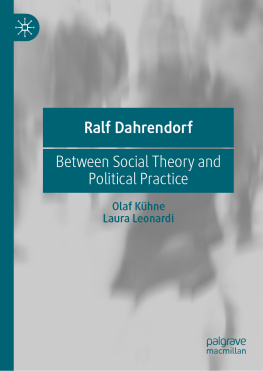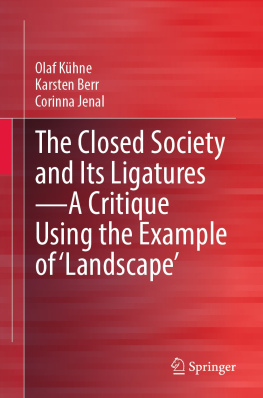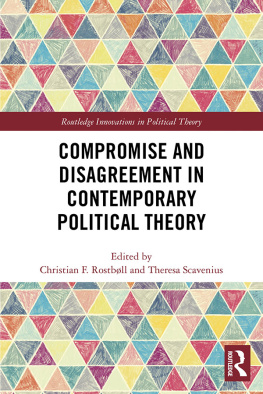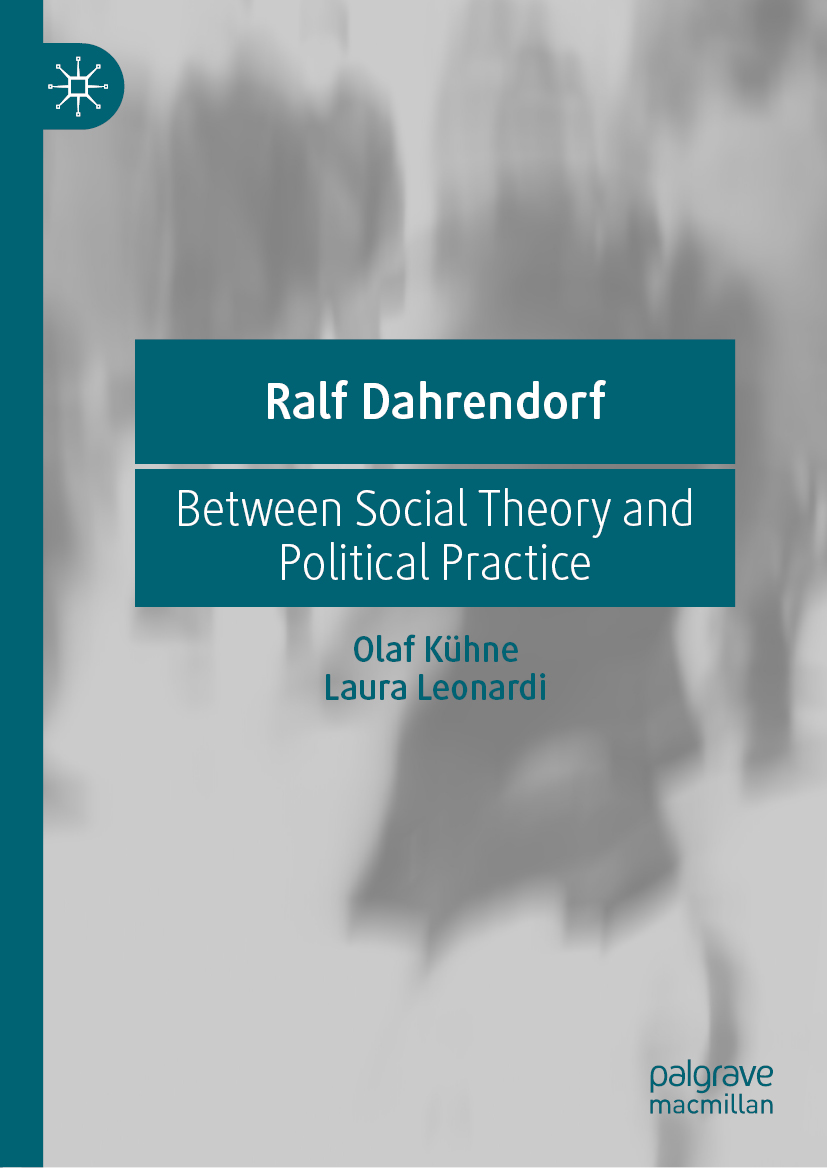Olaf Khne and Laura Leonardi
Ralf Dahrendorf
Between Social Theory and Political Practice
Olaf Khne
Eberhard Karls Universitt Tbingen, Tbingen, Germany
Laura Leonardi
University of Florence, Florence, Italy
ISBN 978-3-030-44296-5 e-ISBN 978-3-030-44297-2
https://doi.org/10.1007/978-3-030-44297-2
The Editor(s) (if applicable) and The Author(s), under exclusive license to Springer Nature Switzerland AG 2020
This work is subject to copyright. All rights are solely and exclusively licensed by the Publisher, whether the whole or part of the material is concerned, specifically the rights of translation, reprinting, reuse of illustrations, recitation, broadcasting, reproduction on microfilms or in any other physical way, and transmission or information storage and retrieval, electronic adaptation, computer software, or by similar or dissimilar methodology now known or hereafter developed.
The use of general descriptive names, registered names, trademarks, service marks, etc. in this publication does not imply, even in the absence of a specific statement, that such names are exempt from the relevant protective laws and regulations and therefore free for general use.
The publisher, the authors and the editors are safe to assume that the advice and information in this book are believed to be true and accurate at the date of publication. Neither the publisher nor the authors or the editors give a warranty, expressed or implied, with respect to the material contained herein or for any errors or omissions that may have been made. The publisher remains neutral with regard to jurisdictional claims in published maps and institutional affiliations.
This Palgrave Macmillan imprint is published by the registered company Springer Nature Switzerland AG
The registered company address is: Gewerbestrasse 11, 6330 Cham, Switzerland
Contents
The Author(s) 2020
O. Khne, L. Leonardi Ralf Dahrendorf https://doi.org/10.1007/978-3-030-44297-2_1
1. Introductory Remarks
Olaf Khne
(1)
Eberhard Karls Universitt Tbingen, Tbingen, Germany
(2)
University of Florence, Florence, Italy
Ralf Dahrendorfs intellectual path is characterized by the continuous crossing of boundariesgeographical, disciplinary, and between different spheres of activity. To describe it, he uses the German term Werdegang (Dahrendorf ): an evolutionary path, which proceeds by trial and error, in private and public life as well as in scientific research, without losing coherence and rigor, in the search for the best conditions so that it can unfold freely. He was not only a social scientist also a publicist, politician , and consultant, as well as a founder and director of scientific institutions. All his activities were permeated by his singular faith in the power of liberty .
Ralf Dahrendorf can be described as a classic of sociology . Particularly in the 1950s and 1960s, he published works such as Soziale Klassen und Klassenkonflikt in der industriellen Gesellschaft ().
Dahrendorfs sociology is clearly based on the reception, reflection, and criticism of numerous social scientists. This concerns for example Herbert Spencer, Robert Merton, and Erving Goffman, but also David Riesman as well as, later, Amartya Sen and critical Jrgen Habermas. Max Weber andin critical debateTalcott Parsons structural functionalism , as does Karl Marxs theory, have special significance for his sociology. His scientific-theoretical as well as his political view of the world was strongly influenced by one person: Karl Popper. About Popper writes Dahrendorf that he owes his thinking more than that of any other author (Dahrendorf , p. 94). Consequently, he has always chosen uncomfortable themes to be developed in his intellectual work as well as to be placed in political life. The years of training are vital to understanding Dahrendorfs research interests, the method, the way of dealing with the relationship between theory and practice , between science and politics, and the liberal perspective. The path of his studies is not at all linear and presents some disciplinary passages that, later, have ended up characterizing his approach in an original way.
Ralf Dahrendorf was characterized by a pronounced publishing activity: It is reflected in an impressive number of manuscripts on books, speeches and lectures, newspaper and magazine articles and interviews (Meifort , p. 303). The special challenge of dealing with the works of Ralf Dahrendorf, apart from their scope, isfollowing his already mentioned positive assessment of conflicts and scientific critiquesthe further development of already published texts and their re-publication in other contexts (e.g., in anthologies). This kind of publishing implies a certain dispersal and fragmentation of central thoughts of sociology , political philosophy, and theory of science in Ralf Dahrendorfs work. It is therefore incumbent upon the author of this synopsis to (re)order his work in an introduction and to establish connections that are difficult to understand at first glance from the large amount of text material. The focus will be on his sociological and political-philosophical work as well as his statements on the social transformation process in Eastern Central and Eastern Europe , plus his reflection upon the social feedbacks of globalization, whichas will be explained in more detailare of great topicality. As his career shows, Ralf Dahrendorf wasthroughout his lifea person who actively participated in political processes, albeit with varying intensity. This is also documented in his numerous written references to day-to-day political issues. In this book, these references are taken up when they are necessary for understanding Dahrendorfs principal patterns of argumentation.
The objective of finding a way to reconcile theory and practice has been accompanied by a constant search for an appropriate method to achieve it: Methodology is the central theme of my life. I do not believe that there is a simple relationship between the scientific world and the political world. I have always rejected the notion that politics can in any way be a translation of social sciences in practice, and I have also rejected the idea that political experience is particularly significant for a social science: they are two worlds with different time scales, with different fundamental orientations. This does not mean that we cannot think of intermediate institutions that develop social science in a way that is similar to politics and policy (Leonardi , p. 124).
Although Ralf Dahrendorf is generally acknowledged as a classic of sociology , particularly in terms of his contributions to role theory , conflict theory, but also to liberal political philosophy, until a few years ago there were no synthetic introductions to his work. In recent years two such introductory syntheses have appeared, in Italian by Laura Leonardi (). These two introductions are highly complementary in their content. While Olaf Khnes introduction focuses strongly on Dahrendorfs terminology and contribution to sociological basic concepts and is very closely related to Dahrendorfs writings, which are mostly initially published in German, Laura Leonardis introduction is more strongly oriented toward the late phase of Dahrendorfs work and more strongly oriented toward the influences and effects of Dahrendorfs writings. Due to the strong complementarity of the two introductions and the lack of such an introduction to the classic Dahrendorf in the English language, we have decided to synthesize our books to complement the more recent literature and to publish them in English. The result is this introduction. This introduction is aimed in particular at people who (for the first time) want to approach Dahrendorfs thinking, certainly mostly students of social and political sciences, but it is also aimed at a periphery audience, not exclusively academic, interested in understanding what theories and concepts to use, and how to use them, for the understanding of social and political phenomena that characterize a constantly changing reality. The approach is not so much the separate treatment of the individual (classical) texts of Dahrendorf as an approach that is thematically structured, i.e., even over several decades of Dahrendorfs publication activity, the individual themes are subject to a process of evolution that should be depicted. Because of Dahrendorfs great inner interdependence of concepts, there are always cross-references that run counter to the linear logic of a book. In concrete terms, this means that it is sometimes necessary to resort to concepts that are more appropriate to deal with in another context. This challenge is met in two ways in this volume. Particularly central concepts, such as that of the life chances , are characterized briefly where the context suggests them and discussed in detail later. For other concepts, a reference is made to the chapter or section in which they are discussed in more detail. The presentation of the development of the individual concepts is based quite closely on the texts by Ralf Dahrendorf, often combined with literal quotations, in order to give readers access to the precision in Dahrendorfs language.







